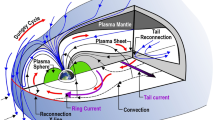Abstract
It has been previously demonstrated that a two-ion (O+ and H+) 8-moment time-dependent fluid model was able to reproduce correctly the ionospheric structure in the altitude range probed by the EISCAT-VHF radar. In the present study, the model is extended down to the E-region where molecular ion chemistry (NO+ and O+2, essentially) prevails over transport; EISCAT-UHF observations confirmed previous theoretical predictions that during events of intense E×B induced convection drifts, molecular ions (mainly NO+) predominate over O+ ions up to altitudes of 300 km. In addition to this extension of the model down to the E-region, the ionization and heating resulting from both solar insolation and particle precipitation is now taken into account in a consistent manner through a complete kinetic transport code. The effects of E×B induced convection drifts on the E- and F-region are presented: the balance between O+ and NO+ ions is drastically affected; the electric field acts to deplete the O+ ion concentration. The [NO+]/[O+] transition altitude varies from 190 km to 320 km as the perpendicular electric field increases from 0 to 100 mV m−1. An interesting additional by-product of the model is that it also predicts the presence of a noticeable fraction of N+ ions in the topside ionosphere in good agreement with Retarding Ion Mass Spectrometer measurements onboard Dynamic Explorer.
Similar content being viewed by others
Author information
Authors and Affiliations
About this article
Cite this article
Diloy, PY., Robineau, A., Lilensten, J. et al. A numerical model of the ionosphere, including the E-region above EISCAT. Annales Geophysicae 14, 191–200 (1996). https://doi.org/10.1007/s00585-996-0191-7
Received:
Revised:
Accepted:
Issue Date:
DOI: https://doi.org/10.1007/s00585-996-0191-7




